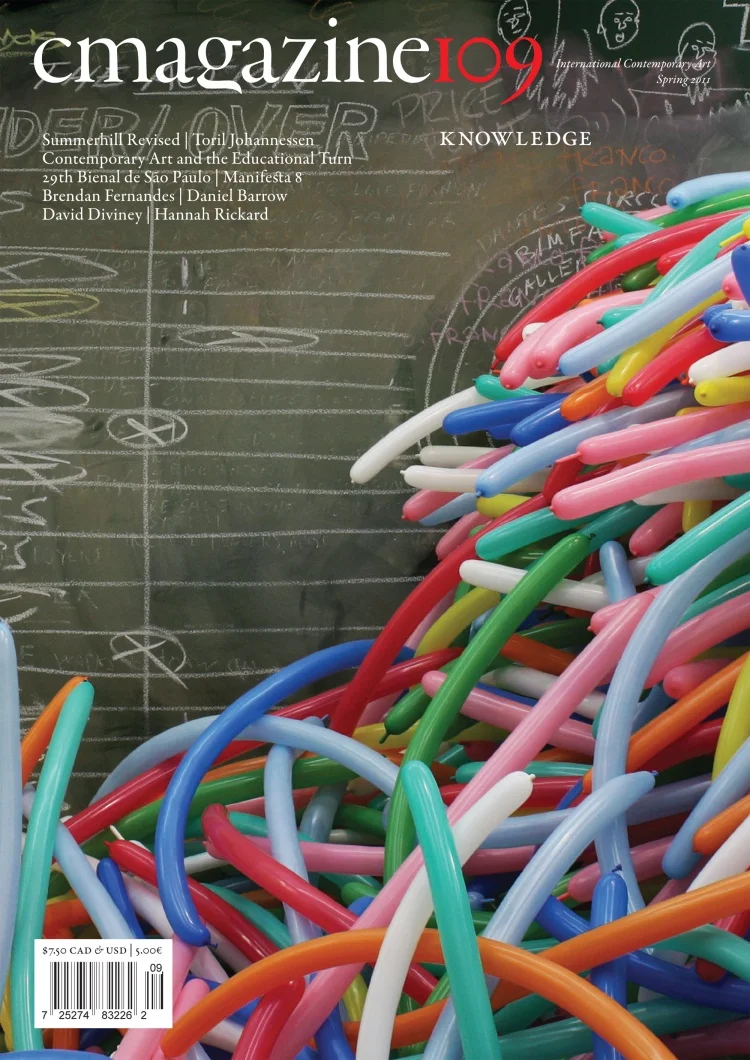C Magazine Issue 109: Knowledge
Spring 2011
Knowledge
Contemporary art has a complex, ambivalent and largely productive relationship to practices of knowledge production. Many artists attempt to elude or circumvent what can be immediately or perhaps rationally known, strategically avoiding the repetition of familiar forms and ideas. The effect is that, hopefully, in some way they transform the known into the unknown. It is what—for me at least—makes contemporary art so uniquely interesting in relation to other forms of cultural practice or intellectual inquiry. When this effect is successful—and success is something that critics and curators, among others, are concerned with identifying—it presents ways of experiencing and making sense of the world that raise new questions.
One of the analytical strands that weaves together recent issues of C Magazine is an examination of themes that have currency within social and cultural realms outside of contemporary art. This approach is based on the premise that looking at contemporary art practices can help us to better understand society at large. While scholars such as art historians and critical theorists very frequently turn to artists to help articulate their own ideas, artists are also deeply influenced by contemporary scholarship and research, and are part of a generative dialogue between people working in and across different disciplines and institutional contexts. The artists whose work appears in this issue of C Magazine are engaged complexly with ideas and questions that extend the influence and relevance of their work into social and professional realms well outside the parameters of its production and exhibition.
By operating outside of conventional disciplinary and institutional confines, artists are able to develop work that also involves publics outside the sometimes seemingly hermetic world of artists, curators and critics. Practices situated in the everyday—from community-engaged forms of public art of the 80s to relational and social practices since the 90s—exemplify this approach. A number of projects discussed in this issue build indirectly upon this history and also incorporate practices of institutional critique. In her essay, “School’s In: Contemporary Art and the Educational Turn,” Jen Kennedy explores the new forms of knowledge that can be produced within existing institutions, and in ways that are alternative to these structures. For instance, in one of the projects she discusses, Jennifer Dalton and William Powhida’s #class, the installation was divided into three areas: “Think Space,” “Work Space,” and “Market Space.” In “Think Space,” the gallery was transformed into an art school classroom, where anyone who came to the gallery was entitled to participate, opening the work up to a broader public and enabling visitors to define and give shape to a collective process. Here, the classroom and those who entered it became the form and content, respectively, of the artwork.
In “You and Me and Her and Us and Them: A Conversation on Using and Being Used,” Sholem Krishtalka interviews novelist Sheila Heti and painter and filmmaker Margaux Williamson about projects in which they are collaborators and muses, while also reflecting extensively upon his own role in their creative processes. Heti and Williamson describe their group as having “created their own MFAprogram right in their neighbourhood, learning only what each other, the Internet, and Toronto could teach them,” a process that is representative of some of the ways intellectual communities form outside of existing institutional spaces, by taking advantage of social opportunities and finding ways to sustain themselves despite limited resources.
Also in this issue, a number of contributors explore the poetic qualities of the representation and dissemination of knowledge. Mandy Ginson interviews Toril Johannessen, who tracks the appearance of words like “crisis,” “miracle,” “logic,” and “love” in academic journals, using conventions of scientific display such as pie charts and bar graphs. This particular way of ordering knowledge foregrounds emotional or spiritual concerns that might seem to be in conflict with the rational nature of scientific investigation. Similarly, in Studies for Possible Futures: vision # 24 (2010), a project appearing inside the back cover, artist Maggie Groat works with images of nature study selected from discarded magazines and science textbooks. Part of a larger series that also includes a collection of images of the moon, her collages look at how people in the past imagined their future place in the world. The centrefold artist project, Summerhill, Revised, by Helen Reed and Hannah Jickling is based entirely on A.S. Neill’s Summerhill: A Radical Approach to Child Rearing, a popular book published in 1960 that outlines the philosophy behind the British radical alternative school of the same name. To create this centrefold, which can be removed and folded into a zine, Reed and Jickling worked with a group of teacher candidates at the University of British Columbia to compile the notes written in the margins of dozens of copies of the now out-of-print book. By foregrounding the material artifacts themselves—in this case, used books purchased from online booksellers and back issues of science magazines—such projects reveal an implicit uncertainty about the authority of these texts and enable us to draw new meaning from them.
Throughout this issue, C Magazine contributors explore sites, processes and tools of knowledge production being incorporated into contemporary art practice as both mediums and subject matter. Like the artists whose work is discussed herein, we hope that doing so will create new ways of engaging and learning.
